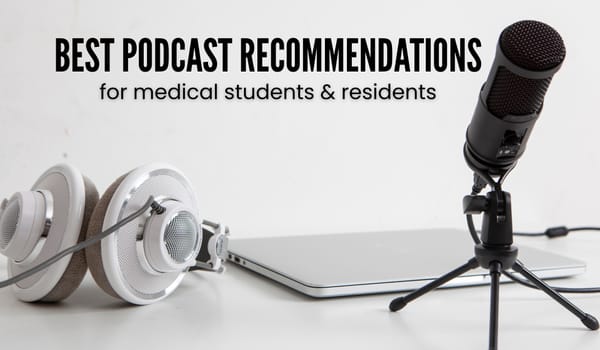Approaching USMLE Step 1 as an IMG
If you’re planning to take Step 1, then you’ve probably spent as much time thinking about it…

If you’re planning to take Step 1, then you’ve probably spent as much time thinking about it (agonizing over it) as I have. I put together this post to explain how I’m going to go about studying for the exam, mostly because I get a lot of questions about it, and because I found it so helpful to read other people’s experiences.
Important disclaimer: I have not yet taken Step 1 therefore I do NOT have my score and I can’t know if my method will work — this is purely to explain what I’m doing, but it’s very very important to do your own research.
[Edit: I decided to split this blog post into TWO parts; in this part ONE, I’ll be discussing the USMLE exam in general, my med school background and my chosen resources. In part TWO, I’ll talk a bit about how to juggle med school classes and studying, how I approach a study session, my First Aid color code and what my “study schedule” is looking like. If you want me to answer anything else, please comment your question below and I’ll include it in part 2!]
Some Key Factoids about USMLE Step 1
First, a quick intro for anyone who doesn’t know what Step 1 is (taken from my Instagram):
🔔 What is it? It stands for US Medical Licensing Exam, and it’s made up of three mandatory parts that are required to pursue medical residency in the United States.
🔔 It’s made up of Step 1 (basic sciences), Step 2 Clinical Knowledge and Step 2 Clinical Skills.
🔔 Why is Step 1 such a big deal? For starters, the score largely determines what hospitals and specialties you would apply to. Although other factors definitely play a role in the application, it’s a major part. Also of note is the fact that you can only take it ONCE.
🔔 What does it cover? It’s a 7-block exam of 40 questions/block covering biochem, physiology, pathology, cardio, renal, musculoskeletal…lets just say, all of the “foundation” medicine classes.
🔔 How do you study for it? The key is First Aid, a book that serves as the bible of the USMLE, and questions, doing lots and lots of questions in the form of Q-banks.
🔔 How much does it cost?
The exam itself is a bit less than $1000, and the key resources (FA and Uworld, the best Q-bank) are between $3-400, depending on the length of the subscription.
🔔What is an IMG?
Me, I am an IMG. This stands for International Medical Graduate, and it refers to any medical student who graduated from a medical school outside of the United States. Step 1 is a difficult exam, and I think studying for it as an IMG has some unique challenges.
My Med School Background (The IMG Life)
I attend medical school in Europe; it’s a 6 year program here, since most students start right after high school. I’m currently nearing the end of my fourth year.
Our uni is from September to June, and it’s split into 2 semesters (Sept-Jan, Feb-June); if you’re interested in how much we study during different points of exam period, check out this blog post here.
First two years, it’s the foundation, the basics; totally theoretical.
Third year is a bit mixed: intro to internal and surgery, along with pathology, microbiology, etc.
Fourth year is mostly clinical, except for pharmacology and public health, our last two full “theory” classes, along with a ton of clinical (dermatology, nephrology, etc.)
Most students at our uni choose to take USMLE after 4th year, because that’s when we’ll have finished all of the “basic sciences” classes.
How I’m Approaching Step 1
Fourth year, 2nd semester: over winter break, I started doing serious research into Step 1. I used a ton of online forums (Reddit, USMLE FB Group, etc.) trying to reading as much as I could and watched a few YouTube videos.
At the end of January, I purchased 6 months of the USMLE Rx 360 platform (more on that later). In retrospect, that wasn’t a terribly great decision, since the beginning of my semester was really busy, so I didn’t use it too much.
My plan was to take the exam maybe in October, early November. That would give me from Feb-October, which would be about 9 months. Perfect, thought little naive me. However, since we still have classes every single weekday, it has been really difficult to study for Step 1, so essentially between February, March and now April, I’ve only done the following chapter read-throughs/associated block questions:
– cardiology
– renal
– musculoskeletal
– pharmacology
– biochemistry (partially)
So now I have to reevaluate a bit, and I’ll share my NEW plan in Part Two.
The Resources I’m Using
Seasoned Step 1 study-ers will know what I mean when I say UFAPS is the definite way to go, but for those of you that don’t, UFAPS is an acronym that sums up the key resources that essentially everyone uses.
U – UWorld Q-bank
FA – First Aid (the bible)
P – Pathoma
S – Sketchy
…and then some…
I’m so far using only FAPS (I have yet to purchase UWorld, but I definitely (absolutely) will).
First Aid: I’m using the 2019 version (if you’re curious how 2019 compares to a previous edition, check out this blog post HERE!). FA is a huge summary document of all the key things; I find this to be very dry, and I could not succeed reading through it by itself.
So I chose to watch accompanying videos. Since I purchased a USMLE Rx (I’ll call it just Rx from here on out), I decided to try the RxExpress videos that are available for almost all FA sections. I find them to be very helpful, and I watch nearly all of them for a given chapter, annotating it into FA as I go along.
Boards & Beyond: I watched a good chunk of these for biochemistry and I LOVED them. I don’t know how they compare to Express because I didn’t watch the Rx videos for biochem (yet), but I really like Boards & Beyond.
Kaplan: a ton of people say that Kaplan videos are good but too long, so I decided not to try them for things like biochemistry, etc. BUT I did watch them for pharma (not all of them, but a good chunk) and they were EXCELLENT. Really really loved their ANS chapter, and I still attribute what little pharm understanding I have to these Kaplan videos.
[Going forward, I would say that B&B is the exact right length, and it was well worth it for me (at least for biochemistry), so I will finish their biochem chapter, and only watch parts that I really don’t understand (like biostatistics) in the future. Otherwise, I’ll stick to the short-and-sweet Express videos.]
Sketchy: even now, without having reviewed ANY of the microbio section in FA, I get 70% of questions associated with micro correctly, and this is all due to Sketchy Micro. A huge time investment, yes, but absolutely essential for doing well in micro (at least, for me). I can’t say enough good things about Sketchy Micro, and I’m so thankful I watched (and annotated) the videos during my 3rd year microbiology classes.
I can’t say the same for Sketchy Pharm, however. I did start watching them in first semester, but I didn’t find it nearly as helpful as Sketchy Micro. That being said, I stuck with it, and I’m glad I did because now that I do Rx questions, I recognize that they cover a lot of the high yield features of almost all USMLE drugs. It seems that ultimately Sketchy Pharm will also be helpful, but I’ll have to invest some more time into them. Since I watched the Sketchy Pharm videos only once and spent minimal time reviewing them, the mnemonics haven’t stuck with me nearly as well as for S.Micro, so I will have to dedicate some time to memorizing Sketchy Pharm pictures properly.
USMLE Rx 360: I got a 6-month subscription for about $170 (it was on sale**) which included all of their products: Rx Q-bank (2,000+ questions), Flash Facts (ready-made flashcards based on First Aid, split into sections), their Study Stream (I have yet to figure out how that works) and finally, their Express videos.
All of their content is really neatly organized into sections that follow FA 2019 to the dot, which is really useful because in a Q-bank question, they’ll refer me to the page(s) where the topic(s) are mentioned. This saves a ton of time (no need to ctrl+F in the PDF or use the index), and makes for a very useful quick reference.
Their videos are generally short and understandable, and they add some useful pointers, tips and mnemonics. I really enjoy watching them, because they make FA more digestible, and you can rate your “confidence” on a topic from green-orange-red, so looking back, you can see what you understood poorly.
Their Q-bank has tutor and timed/untimed modes, and you can select questions based on chapters, or do absolutely randomized questions. Usually I do it based on the section I just studied, in either tutor or timed mode, and then carefully review.
Their flashcards are good for reviewing on my phone (they have a free phone app), but the decks aren’t customizable (I can’t remove cards, make my own, or make decks with more than 200 cards, meaning that I can’t review all of the pharma topics from each system in one giant deck).
Overall, I’m very glad I got Rx (this, by the way, is totally unsponsored), but I know I’ll be switching pretty soon to UWorld. This means that I won’t be able to use/finish all the Rx questions, which is a bit sad — I wish I had been more effective in my Feb-March period, but what can you do.
I am especially grateful that I had Rx because it allowed me to get used to USMLE-style questions. When I first started doing questions, I was so lost on how to approach them that a ton of my earlier blocks felt like a complete waste. I don’t know about others, but I’m thankful that these “wasted” blocks were on Rx and not UWorld, which is the ultimate test-preparation tool.
** Sign up on their website for an account and follow them on Instagram; wait a bit and you’ll likely hear about a discount or sale, so be patient!
Onlinemeded: I absolutely adore their videos. They’re more clinically oriented, so I watched them for my clinical classes last semester, but they also cover a ton of the basics. The cardiology videos on cardiomyopathies and murmurs are still my single favorite reference, because the lecturer doesn’t just state facts, but actually explains it in a way that makes it pure logic.
Osmosis: I used Osmosis almost religiously in 3rd year pathology, and then sort of forgot about it. However, for topics that I have trouble visualizing, I find myself checking YouTube to see if Osmosis has made a video on it, because if they have, I know that that’s a topic I can definitely learn well!
Anki: there are a lot of shared Anki decks that were created for the USMLE (like Zanki and Brosencephalon), but I decided not to use them. Some of the reviews I read pointed out that they might be outdated, and they don’t often get updated, so that’s part of the reason why I decided not to use them. Also, since I have Rx’s Flash Facts, I can use that as pre-made flashcards relevant to FA.
BUT — I love Anki (if you’d like to know what makes Anki such a great program, check out my blog post or YouTube video on Anki here) I am making my own deck. I’m trying to keep it as small as possible, and for now am only including the most useful mnemonics that I want to know for the exam, but I imagine with time it’ll get pretty big.
Thank you for reading! In part TWO, I’ll talk a bit about how I juggle med school classes and studying, how I approach a study session and what my “study schedule” is looking like. If you want me to answer anything else, please comment your question below and I’ll include it in the upcoming part!
If you want to follow on my daily USMLE/med school journey, check out my Instagram!




